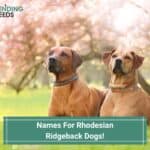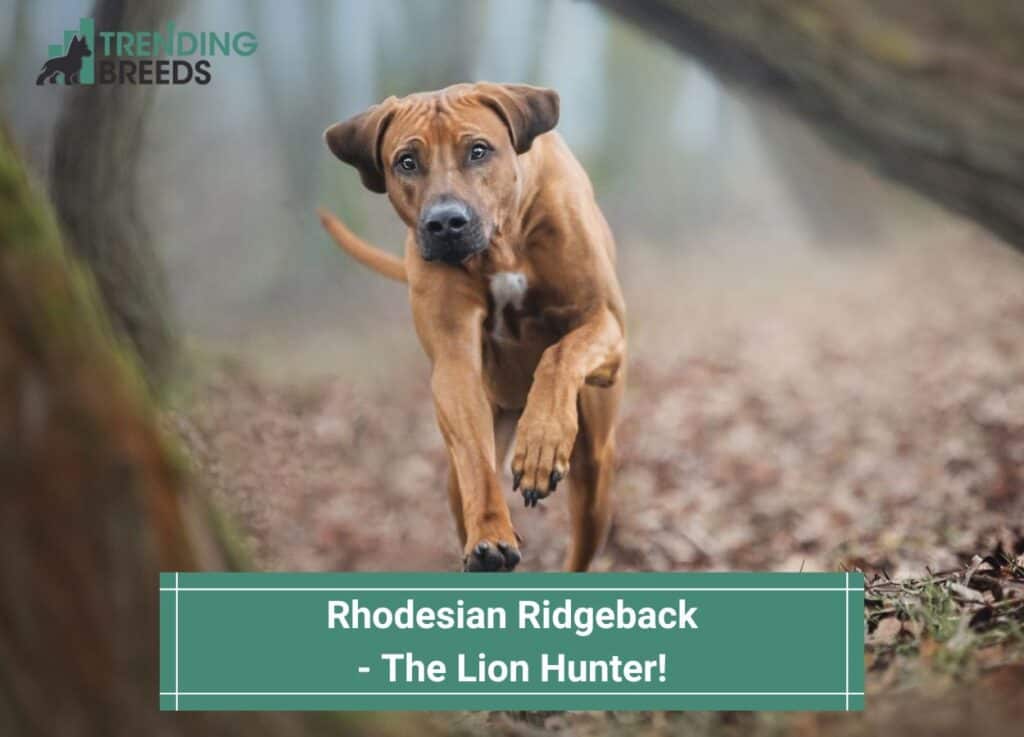
Athletic and fearless with a trademark ridge of hair along its back which gives it the name, the Rhodesian Ridgeback’s claim to fame is its history in hunting lions.
Some people might believe that it means a Ridgeback could kill a lion, but nothing would be further from the truth.
What the Ridgebacks did in the past was hunt in packs, harassing big game like lions until the hunter could catch up and finish the prey off with a close-range shot.
The dogs track game and once scented, the pack would run directly towards the grey while the others circled the flanks to prevent any retreat.
This is where the athletic Rhodesian Ridgeback shines with a remarkable ability to turn on a dime, or run and chase.
Once cornered, the dogs would hassle the prey until the hunter caught up and finished the job!
Rhodesian Ridgebacks have come a long way since their lion-hunting past and are now cherished family pets, protectors, and babysitters. However, they are an active working breed and might not suit some households.
In this blog post, we’ll look more closely at this wonderful breed. Still not convinced that Rhodesian Ridgebacks can hunt lions? Check out the video below:
Other articles you would like: Are Rhodesian Ridgebacks Good House Dogs? and Are Rhodesian Ridgebacks Dangerous?
Table of Contents
Origins Of The Rhodesian Ridgeback
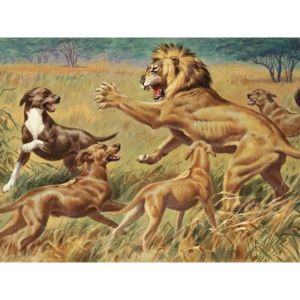
This breed is a cross between the ridged Khoikhoi dog, native to Southern Africa, and several other dogs, most commonly the Greyhound, Bloodhound, Mastiffs, and Great Danes.
They were known as “lion dogs” because they were initially bred to help in hunting wild animals, particularly lions, in the vast plains of Africa.
They were first bred in Rhodesian, now modern-day Zimbabwe, approved by the South African Kennel Union in 1927, and recognized by the American Kennel Club in 1955.
Their most distinctive feature is the ridge of hair growing on their backs in the opposite direction as their fur.
Can A Rhodesian Ridgeback Kill A Lion?
Contrary to popular belief, the Rhodesian Ridgebacks that historically hunted lions did not actually kill the lion. If a lion were to get into a fight with a Ridgeback or even a pack of them, the lion would clearly win.
What Does A Rhodesian Ridgeback Do When Hunting Lions?
The Ridgebacks hunted in packs of four or more. Once they scent a lion or any other wild game, their job was to chase the animal as a team and harass it until the hunter could catch up and get in a close ranged shot.
Rhodesian Ridgebacks are medium to large dogs that typically weigh between 65 and 80 pounds, with males being on the larger end of the scale. They are also one of the tallest breeds of dog, measuring up to 27 inches at the shoulder.
In contrast, a lioness weighs between 270 and 400 pounds while a male lion can weigh up to 570 pounds.
What Else Do Rhodesian Ridgebacks Do?
While they no longer hunt lions, they still have a strong prey drive and make excellent hunting dogs. Ridgebacks are most commonly used for hunting baboons, deer, bear, boar, and other large game. They are also one of the few breeds of dog that can be safely used for bird hunting.
They also protected their owner’s property and herded some cattle for farmers in the past. This versatile breed can do it all!
Do Rhodesian Ridgebacks Have A High Prey Drive?
Like all hunting dogs, Rhodesian Ridgebacks have a high prey drive and are likely to chase smaller animals and children.
They need extensive amounts of exercise to keep the high prey drive in check to prevent them from taking off. If you have a Ridgeback, they should always been on a leash, and they will also need to be kept in the yard with a high fence.
Ridgebacks are athletic dogs are notorious escape artists, and some of them have been known to be able to leap a six feet tall fence!
Temperament
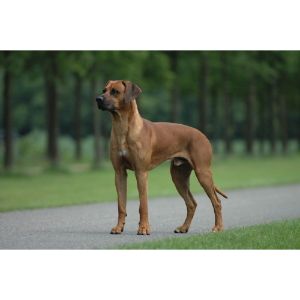
Rambunctious would be the perfect adjective to describe this dog’s demeanor. The Ridgeback is a born athletic, historically bred for running at speed over long distances to hunt wild big game in Africa, so they are excellent scent hounds.
They are well suited as guard dogs, so your family will have an extra layer of protection. In addition, they are capable of running fast and can give the fastest dogs in the world a run for their money.
All these factors combined make this dog breed an ideal candidate for dog competitions, especially athletic ones where they shine like agility and flyball.
The Rhodesian Ridgeback exudes domineering and independent energy and will push their boundaries and test their limits and your patience!
They are intelligent dogs that need early and extensive socialization.
They can also be stubborn and strong-willed and will not suit weak or inexperienced owners. Their background as hunting dog means they might also have a high prey drive and will need a fenced yard.
Early socialization with smaller animals and children is crucial to having a well-balanced, calm Rhodesian Ridgeback.
Despite their domineering nature and intimidating look, these dogs are fiercely loyal to their owners and their owner’s family.
They enjoy being around their human family and become very attached to them. Don’t be surprised if they follow you around like a toddler because they are happiest in your presence.
Color
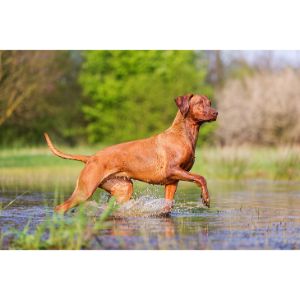
Wheaten is the only color accepted by the AKC, but some Ridgebacks have been known to be blue.
Wheaten can range from pale yellow to dark brown. The breed was intentionally bred in this color for efficient camouflage in the African savanna ecosystem.
Lifespan
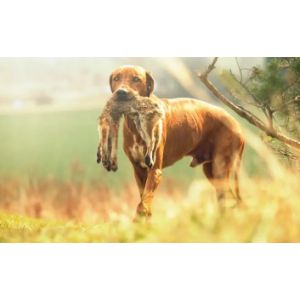
The Rhodesian Ridgeback has a life expectancy of 10 to 12 years. They are large dogs that will take longer to reach their full height and weight, which will be around 12 to 14 months.
Some Rhodesian Ridgebacks, especially the males continue to grow until they are two years old.
Size
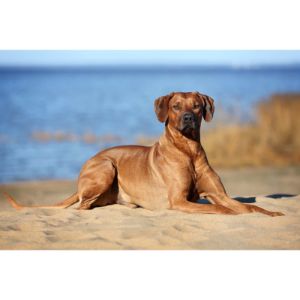
A fully grown male is between 25 to 27 inches (63.5 to 68.58 cm) tall while a fully grown female is 24 to 26 inches (60.96 to 66.04 cm) tall.
In terms of weight, the female weighs 70 (31.75kg) pounds on average while the male weighs between 80 to 90 pounds (36.29 to 40.8 kg).
Barking Tendencies
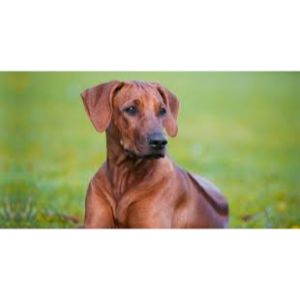
When it comes to barking, this is one of the least yappy dog breeds because they rarely bark.
This quality makes the Rhodesian Ridgeback appealing especially for people who like their peace and quiet. They bark so seldom that when they do, it is best to find out why.
Nutrition
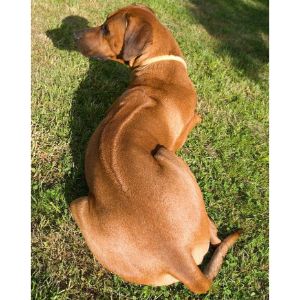
Rhodesian Ridgebacks are active dogs that will require top-notch nutrition. They are also likely to have hearty appetites and are not known for being finicky eaters.
As long as you keep filling its bowl, it will keep eating. Their huge appetites make them prone to becoming overweight and obese.
Since obesity has as many negative effects on dogs’ health as it does on humans, this is a situation you would like to avoid. To prevent obesity, weigh your dog regularly and reduce portions slightly if the results are concerning.
On average, this breed needs about 640g to 780g of food each day when it’s an adult.
Feed them puppy food until they are about 15 months old then switch to adult dog food. Ensure you select food that is meant for large dogs so that your dog has enough nutrients for its needs.
In addition, pick quality dog food because they are more likely to contain all the nutrients and in the right amount for your dog. Dog treats are a great way to train your dog and reward it, but they should be moderated so that they don’t become overweight.
You should also look out for a Rhodesian Ridgeback eating food from the kitchen counters and other surfaces. They love food and if you leave some lying around within reach, they are going to get into a lot of trouble!
Grooming
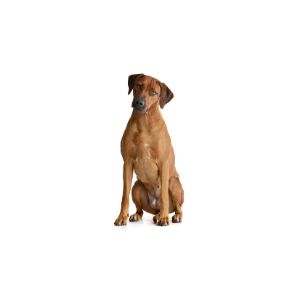
Overall, this dog’s grooming needs are quite low. The Rhodesian Ridgeback is a moderate shedder although the shedding lasts all year round. Since they don’t shed too much, their shedding can be managed by regular brushing.
As little as one brushing session a week is enough to keep your dog’s fur coat looking glossy and maintain its skin’s health.
This breed does not require baths too often. On average, a bath every few weeks is enough to clean out any dirt and debris that remains even after their weekly brushing.
It is recommended that on bath days, you wash your dog twice for the best results. Remember to use dog shampoo when washing the dog and not human hair shampoo.
Other than their fur coat, a Rhodesian Ridgeback also requires their nails clipped and ears cleaned. They are not partial to getting their nails clipped, so they may give you a hard time while you are doing it.
Early grooming and desensitization are necessary to have your Ridgeback happily accept your grooming attentions.
Like all dogs, they will need their ears cleaned every week or so to keep the mites, bacteria, and infections at bay.
Health
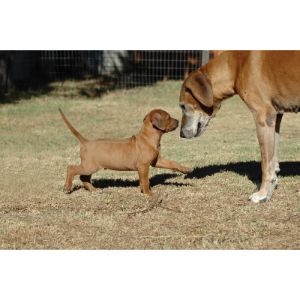
In general, the Rhodesian Ridgeback is a naturally healthy dog breed with great stamina. However, like all dogs, they can be predisposed to a few genetic conditions.
Hip and Elbow Dysplasia
This is one of the most common health issues faced by this breed. Dysplasia is a general term that refers to abnormal growth that leads to degenerative changes in the joints of the hips or elbows of dogs.
This condition is endemic to large dog breeds like the Rhodesian Ridgeback.
It can lead to weakness in the affected limb, and pain, and in severe cases, it can lead to lameness. If your dog avoids putting weight on one limb then it may have dysplasia. This condition is not fatal and lots of dogs live quality lives even with it.
Thyroid Issues
This dog breed is also prone to thyroid issues, particularly hypothyroidism. Hypothyroidism results from the underproduction of the thyroid hormone.
This condition leads to a variety of metabolic issues including low energy, weight gain, skin issues, and in rare conditions seizures and heart issues. Hypothyroidism is not life-threatening especially if diagnosed and managed as per the vet’s recommendations.
Dermoid Sinus
Dermoid sinus is a condition that results in tube-like openings under the skin, commonly on the neck and the spine. It is a birth defect that is unique to this dog breed and can be detected early.
It is a result of congenital malformations of the skin and nerves and can be removed surgically depending on their severity. Fortunately, this is also not life-threatening in most cases.
Do Rhodesian Ridgebacks Get Along With Other Animals?
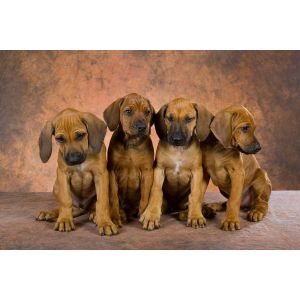
This dog breed is all cute and cuddly when it comes to familiar people and even pets. The Rhodesian Ridgeback gets along even with cats as long as they grew up around them. However, with unknown pets and people this dog is not as friendly.
Rhodesian Ridgebacks can get aggressive with unfamiliar people, dogs, and other pets. You should always have it on a leash in public places like the park or when you’re walking your dog in the neighborhood.
In addition, the Ridgeback is a hunting dog and as such, will probably have a high prey drive and like to chase smaller animals, even if it doesn’t mean any harm.
You’ll need to keep a close eye on small animals and children around an unleashed Ridgeback.
Are Rhodesian Ridgebacks Good With Kids?
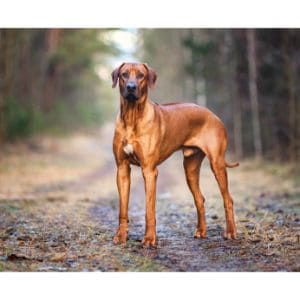
Rhodesian Ridgebacks can be great with kids! They have boundless energy and will make a very good playmate for any child. They are protective and loyal and make excellent babysitters.
However, they should be supervised with younger children because they can be overzealous as they play with children.
Exercise Needs
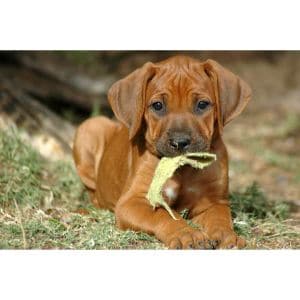
These canine athletes are active dogs that need loads of exercise; about one or two hours a day.
A mere stroll around the park isn’t sufficient, so you’ll have to do more vigorous activities like going for a run, a long hike, or playing a vigorous game of fetch.
You can also participate in agility classes. Ridgebacks love physical activity, and a bored dog can display destructive behavior like chewing and digging.
Which Is The Strongest Dog?
In addition to the Ridgeback, some other dogs are known for their strength and power.
- Mastiff
Mastiffs are large, powerful dogs that have been bred for centuries to protect property and defend against intruders.
Though they can appear imposing, Mastiffs are actually gentle giants that are loyal and affectionate with their families. They are also known for being patient and good with children.
- Rottweiler
The Rottweiler is a large, powerful breed of dog that has its origins in Germany. Traditionally used as a working dog, the Rottweiler is patient and protective, making it an excellent guard dog. It is also intelligent and obedient, making it a popular choice for police and military work.
- Irish Wolfhound
The Irish Wolfhound is a gentle giant among dogs, standing as tall as 36 inches at the shoulder and weighing up to 120 pounds. Despite their intimidating size, these dogs are actually quite docile and are known for being affectionate with their families.
They are also intelligent and trainable, although their independent nature means that they may not always be willing to follow orders. The Wolfhound’s origins date back to ancient Ireland, where they were used as hunting dogs and guard animals.
- Saint Bernard
Saint Bernards are one of the most iconic dogs breeds. They are large, shaggy dogs with a reputation for being gentle giants. Saint Bernards originated in the Swiss Alps, where they were used as working dogs. They were bred for their strength and size, as well as their ability to withstand cold weather.
Today, Saint Bernards are still popular working dogs, but they also make great companion animals. They are loyal and protective of their family, but they are also patient and good with children.
Which Dog Has The Strongest Bite Force?
While Rhodesian Ridgebacks were historically used to hunt lions, their job wasn’t to actually bite the lion but rather, to haress and distract the animal until the hunter was able to get in with the killing shot.
However, if you were wondering about other dogs that have incredible biting power, here are a few powerful ones.
- Kangal Shepherd
Kangal Shepherds are known for their powerful bite force. In fact, they have the strongest bite force of any dog breed, at over 700 pounds per square inch. This is double the bite force of a German Shepherd and a Pit Bull.
Kangal Shepherds are native to Turkey, where they were originally bred to protect flocks of sheep from predators like wolves and bears. Today, they are still used as working dogs in many parts of the world.
And while they may seem intimidating, Kangal Shepherds are actually gentle and loving dogs that make great family pets.
- Cane Corso
The Cane Corso is a large and powerful dog, capable of inflicting serious damage with its bite. Studies have shown that the average Cane Corso has a bite force of 650 PSI, which is significantly higher than the average dog.
However, it’s important to note that bite force is not the only factor that determines how dangerous a dog can be. Size, weight, and temperament are also important considerations.
Conclusion For “Rhodesian Ridgeback – The Lion Hunter”
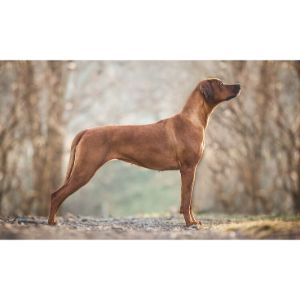
While lion-hunting is a thing of the past, the Rhodesian Ridgeback still has many of the qualities that it was originally bred dog.
Athletic, fearless, and fiercely loyal, Ridgebacks will make an excellent addition to a household that has the time to train, socialize, and exercise them.
You will also like:
- Rhodesian Ridgeback Puppies In California
- Rhodesian Ridgebacks: The Good And The Bad
- Why Don’t Basenjis Bark?
For more information about the Rhodesian Ridgeback Breed, check out the video below:




